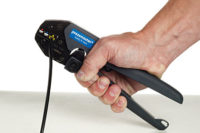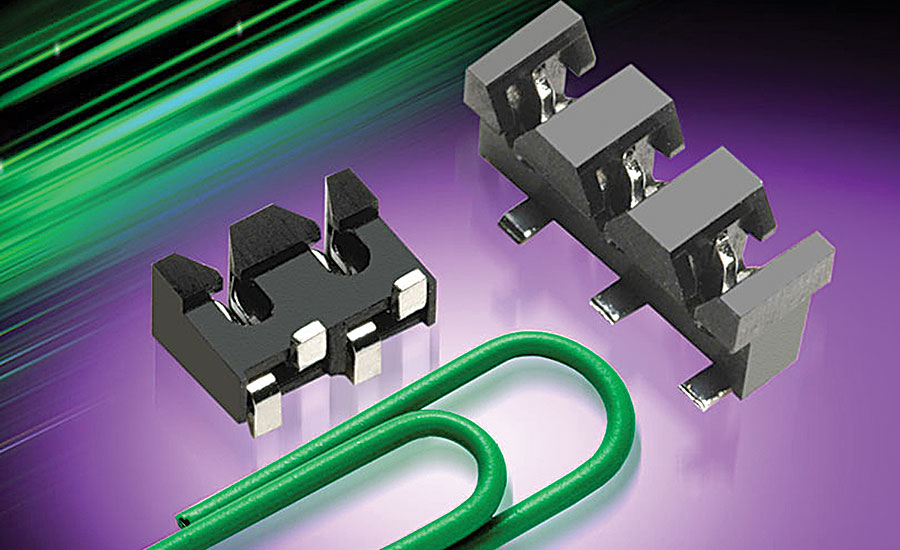Insulation Displacement Connectors Are a Reliable Alternative to Crimping

IDCs provide a cost-effective alternative to crimping and soldering. Photo courtesy AVX Corp.

By eliminating wire stripping and crimping, IDCs facilitate the rapid assembly of high-density wiring harnesses. Photo courtesy AVX Corp.

The biggest benefits of using IDCs are simplicity and reliability. Photo courtesy AVX Corp.

IDC connectors mechanically force unstripped wire under moderate pressure into a V-shaped fork. Photo courtesy ETCO Corp.




Electrical wire connectors come in all shapes, sizes and colors. One popular alternative for applications in harsh environments are insulation displacement connectors (IDCs).
An IDC is a mass termination connector for flat cable with contacts that displace the conductor insulation to establish simultaneous contact with all conductors. A contact pierces through the wire’s insulation to achieve a gastight interface. As the connector deforms, the individual conductors create a metal-on-metal connection between each strand, while holding it under compression from two opposing high-force beams.
The contact can accept both solid and stranded wires, which allows IDCs to be used in a broad range of applications. They support temperature requirements ranging from –40 to 125 C. IDCs have also been tested to withstand up to 50 g of shock.
IDCs provide a cost-effective, reliable alternative to crimping and soldering. They save time and money by eliminating the need to strip insulation from a wire prior to termination. In addition, simple insertion tools are available for the wire termination process.
The main difference between a crimp and an IDC contact is the way in which wire deformation is achieved. With crimps, the prestripped wire and terminal are severely deformed under high pressure crimping dies to achieve metal to metal contact. This involves deforming the terminal and axially extruding the wire by applying a relatively high force per contact.
However, much lower forces are need for IDC terminations. Insulated wire is pressed into a slot that displaces the insulation and removes oxides by deforming the wire with shear forces.
“IDC connectors work by mechanically forcing unstripped wire under moderate pressure into a V-shaped fork,” says Ralph Jacques, general manager at ETCO Corp. “The inside edges of the fork are blades that slice through the insulation as the wire is pushed between them.
“As the insulation is cut and pushed aside, the bare wire is exposed and comes in contact with the terminating blades,” adds Jacques. “The blades also penetrate any surface oxides that may be on the wire.
“Insulation displacement connectors are used as a means to reliably and cost-effectively connect high volumes of wires for power and data applications,” notes Jacques. “[They] are an invaluable product when it comes to connecting large volumes of wire.”
By eliminating wire stripping and crimping, IDCs facilitate the rapid assembly of high-density wiring harnesses. And, they can be supplied in strip form to accommodate automated wire processing equipment.
Insulation displacement connectors have been around since 1959 and show no signs of becoming antiquated. They can be found in numerous applications, including appliances, ATMs, automotive safety systems, computers, irrigation equipment, motors, pumps, security systems, solar energy, solid-state lighting and telecom gear.
“IDC contacts have been automotive-qualified for several years in air bag, engine and transmission control units,” says Tom Anderson, product manager at AVX Corp. “This is an unbelievable testimony as to how well these connectors can perform in mission-critical systems.”
“[Our] customers continue to find new and interesting applications for IDC technology,” adds Brad Blietz, global business manager for 3M’s Electrical Markets Division. “The simplicity of the IDC design has negated the need for redesigns. It’s an elegant solution that’s widely used and reliable.
“We have not seen another solution to replace IDCs,” claims Blietz. “The benefit of time and cost savings, in addition to ease of installation—because they simply clamp on with no need to strip wires—makes IDCs a very compelling choice.”
Several different contact materials can be used. Options include beryllium copper, brass, phosphor bronze and tinned brass.
“All of our IDC connectors are designed for use with copper conductors,” says Blietz. “To choose the correct connector, engineers need to know the type of connection, such as tap, pigtail or double run; environmental issues, such as vibration, temperature and moisture; and wire sizes.”
Engineers at 3M first developed IDC technology for electronic applications more than 50 years ago. “Back then, it was for 28 AWG, seven-stranded wire,” notes Anderson. “Today, IDCs can range from 12 to 32 AWG. So, what started as a multiconductor ribbon cable solution for computers and industrial equipment has moved into a more discrete, lower pin-count offering.”
According to Anderson, IDC technology has come a long way from its early origins. “Today, many solar energy and smart grid applications are using 12 and 14 AWG wires to handle either high current or long wire runs,” he points out.
“On the opposite end of the spectrum, we see 26 to 30 AWG wiring used in sensors and general components attached to printed circuit boards,” explains Anderson. “In the middle is the solid 18 to 24 AWG range used for industrial and transportation applications.”
Typically, the type and size of wire being used does not affect the IDC selection process. “As long as the contact has been designed to match a specific AWG, the process remains basically the same,” says Anderson.
“12 AWG is the largest size wire you can use with IDCs, because of mechanical and force limitations,” notes Anderson. “On the other hand, 32 AWG is the smallest size wire that is ideal for IDC applications because of the stamping technology needed to produce a small slot in a thicker contact material.
“From a wire perspective, we see all different constructions used in conductor and insulation materials,” Anderson points out. “In fact, we can terminate uninsulated or bare wires with no concerns. We use this a lot in automotive applications where we are connecting solid leads from electolytic capacitors, resistors or even inductor coils.”
According to Anderson, the biggest benefit of using IDCs is simplicity and reliability. “By nature, IDCs eliminate the process of stripping and crimping contacts onto a wire,” he explains. “Traditionally, it was a two-piece solution mating to a header on a PCB. Today, there are several one-piece solutions on the market, which then eliminates a connector.”
“One of the biggest mistakes that engineers make with IDCs is not giving them a try,” claims Anderson. “Selecting a properly designed contact system can provide a reliable gastight connection to provide years of reliability.
“Unfortunately, some people have heard of past issues in the market or are just unaware of the advances that IDC has made in the last 50 years,” adds Anderson. “The biggest myth or misperception about the technology is reliability. There are more than 250 different IDC products on the market, and they are not all made the same.
“Most people remember the days of grey computer cables, which worked well in that application,” says Anderson. “As engineers started migrating into harsher applications, they started to experience field failures. Today, there are IDC connectors that can survive high temperature, shock and vibration applications if the base contact material and geometry have been designed for these applications.”
Looking for a reprint of this article?
From high-res PDFs to custom plaques, order your copy today!










